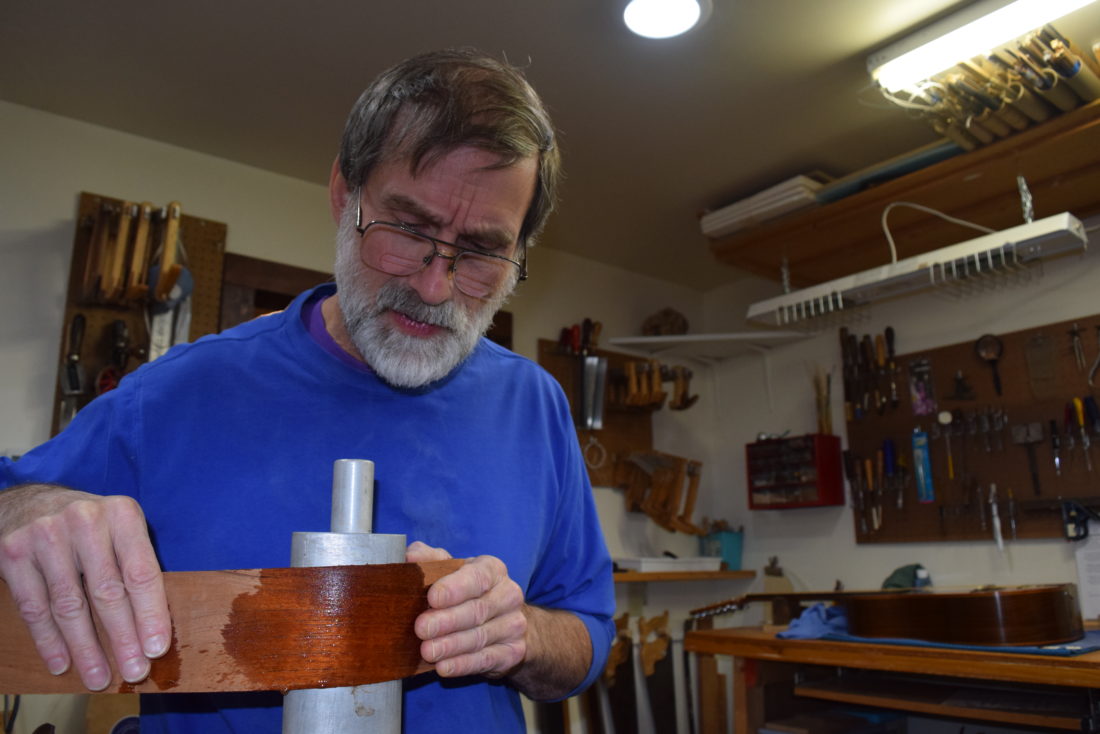From good wood to excellent instrument

Luthier Bruce Thompson demonstrates how wood for his guitars is shaped into curves and bends by wetting and applying heat on Wednesday. (Enterprise photo — Jesse Adcock)
SARANAC LAKE — Looking at a piece of good wood, a guitar maker is faced with all kinds of questions. There are worries to be had about thickness and bracing. Of essential concern is tone and playability. How stable will the construction of the instrument be in five years … 10?
After 45 years of classical and flamenco-style guitar making, luthier Bruce Thompson has these thoughts when looking at instruments. But at 18, in a guitar repair shop ogling a prewar Herman Hauser classical guitar, all Thompson thought was, “Well I’m never going to be able to afford this.”
Later, while reading a how-to book on guitar building, Thompson thought, “There’s no way I could do all that.”
“But its like many projects,” Thompson said. “Step one isn’t terribly hard. Two’s not terribly hard either. So, I ended up at a guitar maker’s shop in Maine … in January of ’73. And I saw guitars being made. And gee, each step of the process didn’t seem that impossible.”
That summer, Thompson stopped by a lumberyard. He bought a good chunk of redwood. From that summer on, Thompson experimented with building his own guitars. A friend of Thompson’s step-father had a lot of good wood lying around his attic. And so Thompson had his first commission.

Luthier Bruce Thompson plays a guitar of his own creation Wednesday in Saranac Lake. (Enterprise photo — Jesse Adcock)
“And for a chunk, a stack, of black walnut and a little money, he wanted me to build his daughter a guitar,” Thompson said. “So after I built two terrible guitars, I actually built a fairly nice little guitar for his daughter.”
Thompson got out of the game for a few years after grad school. He got married. He had kids.
“And we found ourselves living on an Indian reservation while I worked for the Indian health service from ’86 to ’90,” Thompson said.
Phoebe Everson, Thompson’s wife, happened upon a marked-down, 6-inch table belt sander in Sears, and brought it home to surprise Thompson. A week later, the couple went out to a pharmacy for cold medicine for their children. They saw a good deal on a drill press.
“The Walgreens Pharmacy in Billings, Montana was also a Coast to Coast Hardware,” Thompson said. “Suddenly I had a whole bunch of tools. And long, long winters — long, dark cold winters. And so I started building again.”
Thompson and Everson moved to Saranac Lake a year and a half ago. They’d been coming up to the village for years to cross-country ski, from Peru, outside Plattsburgh.
“We finally said, ‘Why are we still living down here? We don’t work down here anymore, our kids aren’t in school down here anymore.'” Thompson said. “So we came up here.”
Now, Thompson said he builds between six and nine instruments a year, out of a workshop on his property. The workshop hosts that old 6-inch table belt sander and drill press that got him back into making. Thompson’s process takes him around 90 hours per instrument if he’s not making the rosette — the mosaic inlays that wrap the sound holes of flamenco guitars. They’re work intensive, taking more than 20 hours to set and cut.
Thompson orders rosettes online now, but is still willing to make them if a customer’s looking to pay for more than 20 hours of extra work.
The wood used for the guitar top makes the biggest difference in quality, Thompson said. When looking at a piece of wood, a tight and even grain is most desirable.
“It provides a measure of uniformity of stiffness to weight across the top,” Thompson said. “When you get a handmade instrument, you get someone who is thinking about, and altering, what they do with every piece of wood that goes through their hands. Every piece of wood is different.”
That uniqueness determines how Thompson puts a guitar together. Take, for instance, two guitars that he built in April and September of this year — both with tops of western red cedar.
The April guitar top was flexible across the grain. Much more than most cedar Thompson said he works with. He was worried that the wood would flop too much when the strings were struck. This may have resulted in a tone that wasn’t bright enough.
“So I added a brace all the way across the top, underneath the bridge,” Thompson said. “Very thin. Arched sort of like a railroad trestle. Just to stiffen it all the way across the top.”
The September guitar was stiff. That particular cedar top was one of the stiffest Thompson said he’d ever worked with.
“So as I was getting near to where I normally thickness to, I stopped,” Thompson said.
A top so stiff could make a guitar’s tone brittle. So Thompson left on some mass. As a result, he didn’t need to brace the top as much to support the strings’ pull.
“That guitar is exceptional,” Thompson said. “The stiff top … the reduced bracing and the amount of wood mass that gets going when those things move it — that thing has incredible sound.”
He said the April guitar was nice, and sounds much better because of the brace.
“That’s an example of working with what you have to get the best out of it.”
Those thickness changes were large alterations to a luthier like Thompson. But to someone outside of the trade, the phrase “leaving it thick” probably doesn’t come across as a fraction of a millimeter’s difference.
“Basically taking a very sharp chisel, and I’m shaving off almost paper thin slices,” Thompson said. “Then just feeling it and flexing it until I think I’ve got something I like. And tapping on it to hear the resonance as I shave it down.
“Now I’m not going to reproduce that per se,” Thompson said. “I’m just going to use the same principles on the next guitar.”
That said, some elements of guitar building are relatively standard, and some makers measure and reproduce components of the same specifications. In a factory this is a necessity of mass production. But Thompson said some independent makers do this as well. He said when they’ve found an optimal template, they try to reproduce that in every piece.
“I am not — I’m trying to get the best sound out of every instrument,” Thompson said. “This particular piece of wood.”
Thompson works with a variety of materials — from redwoods to western red cedar, to port orford cedar, several kinds of spruce, among many others.
“Sometimes I get it really right,” Thompson said. “Sometimes I get it … okay.”
The multiple levels of attention a craftsperson is paying separates a handmade guitar from a factory-produced instrument. There’s the hyper-awareness of the material construction, but on another level, there’s the instruments use — its playability. Even the best sounding instrument is no good if it isn’t easy to play, Thompson said.
“So when I get to the point, or any builder gets to the point of saying, ‘Okay, now I’m doing the fret board, I’m doing the bridge, I’m setting up the action, I’m shaping the neck’ — all of those things that make it work for the hands,” Thompson said. “If they’re putting all that time and effort into getting great sound, then they’re going to put an effort into getting great feel and playability.”
What it comes down to is care and attention. Using an ultra-rare piece of Brazilian rosewood or German spruce doesn’t guarantee a mind-blowing sound. A competent builder, Thompson said, can take some pretty lame wood and make an amazing instrument out of it.
“But obviously, one prefers to work with good wood.”



